Painting techniques are methods and skills that artists use to apply paint to a surface to create a work of art. There are many different painting techniques, each with its own unique effect.
Painting styles are subjective to an individual artist and reflect that person’s unique type of painting. In contrast, painting techniques refer to the artist’s method or procedure while painting. For example, Van Gogh’s paintings use the Impasto technique, but his painting style was mostly that of the Post-Impressionists.
There are many different painting styles to learn, including older ones like Rococo, Renaissance, and Baroque, and more modern styles, such as Pop Art, Cubism, and Surrealism. Knowing the different kinds of painting techniques makes your work more diverse, allows you to be more versatile, and encourages you to experiment and adapt your style. You could also get into teaching others and might even make a career in the art field.
Keep reading to learn about the types of painting styles and techniques, and prepare to unleash your inner creativity!
What Are The Different Types Of Painting Techniques?
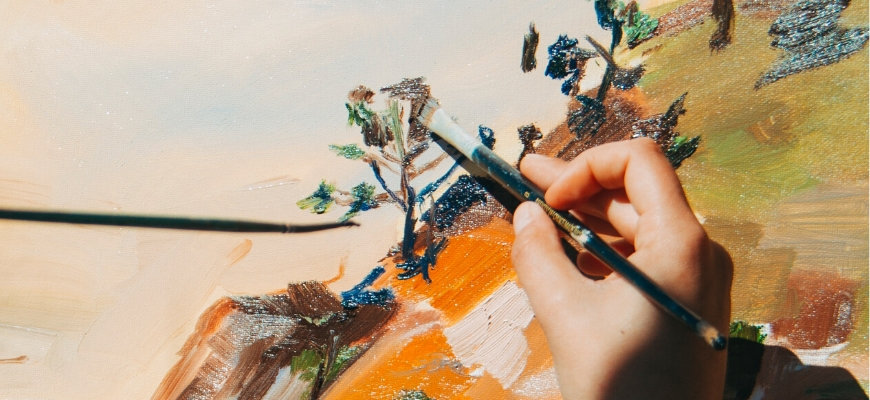
The different types of painting techniques and painting methods are incredibly varied, so you’ll always have a fresh source of inspiration, and your new hobby will never get boring!
Acrylic Painting
Acrylic painting uses acrylic paint, which is water-based and fast-drying. The paints can be applied by brushes onto canvas, paper, or wood, and you can easily build up layers, allowing for a wide range of techniques to be used.
Action Painting
Action painting is a form of abstract expressionism where you create dynamic and spontaneous artworks by using dripping, splattering, or gestural brushwork. Action painting often emphasizes the physical act of painting rather than the finished image.
Aerial Perspective
This technique creates depth in a painting by showing distant objects in softer colors, lower contrast, and with less detail to replicate the way in which the earth’s atmosphere affects our perception of things.
Anamorphosis
Anamorphosis is a distorted image that looks normal when you view it from a particular angle or with a device, such as a cylindrical mirror. This technique is often used to create optical illusions in paintings.
Camaieu
Camaieu is a monochromatic painting technique where you use a single color or a limited range of closely related colors to create a subtle, tonal composition, usually of shapes and patterns rather than specific objects.
Casein Painting
Casein is a milk-based medium that you mix with pigments to give it the color you want. You can use casein on various surfaces, and it dries to a matte finish.
Chiaroscuro
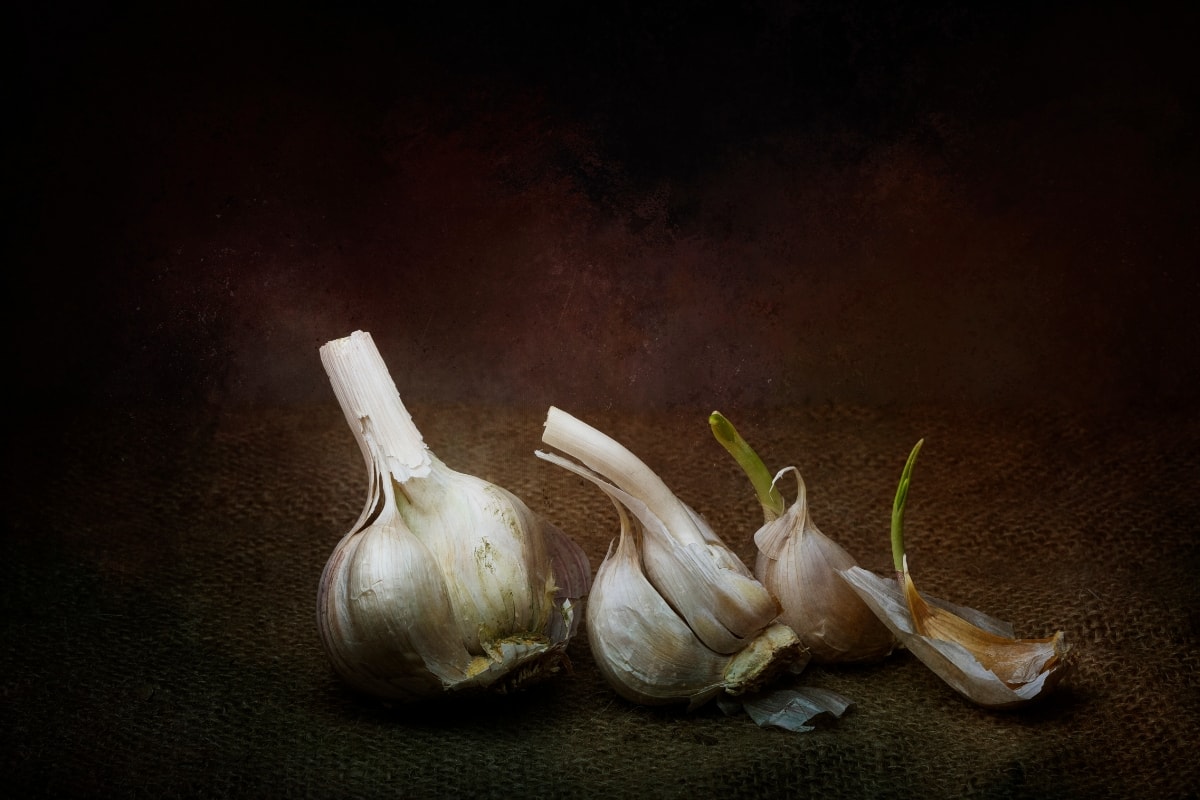
Chiaroscuro is a painting technique that emphasizes the contrast between light and shadow to create a three-dimensional effect in a painting and is typically associated with dramatic lighting in a home decor setting.
Divisionism
The divisionism painting technique is like pointillism in that you apply tiny dots or strokes of color to your canvas or paper. When viewed from a distance, those colors blend to create an image.
Easel Painting
An easel is used to hold a canvas while you paint. Easels can be used indoors and outside, depending on your subject matter, to provide a convenient workspace.
Encaustic Painting
Encaustic or hot wax painting uses colored, heated beeswax applied to a surface, typically wood or canvas. The artist then sculpts or fuses the wax with heat to produce a textured artwork.
Foreshortening
Artists use the foreshortening technique to create the illusion of depth by making an object or figure appear shorter or compressed when you look at it from a specific angle.
Fresco Painting
Fresco painting involves applying colored pigments to a wet plaster surface. The paint bonds with the plaster as it dries, making fresco a durable technique that is typically used to create murals.
Gouache
The gouache painting technique is similar to watercolor painting but uses additional white pigment to create an opaque image. This technique is often used on paper for illustrative work to create detailed images.
Graffiti
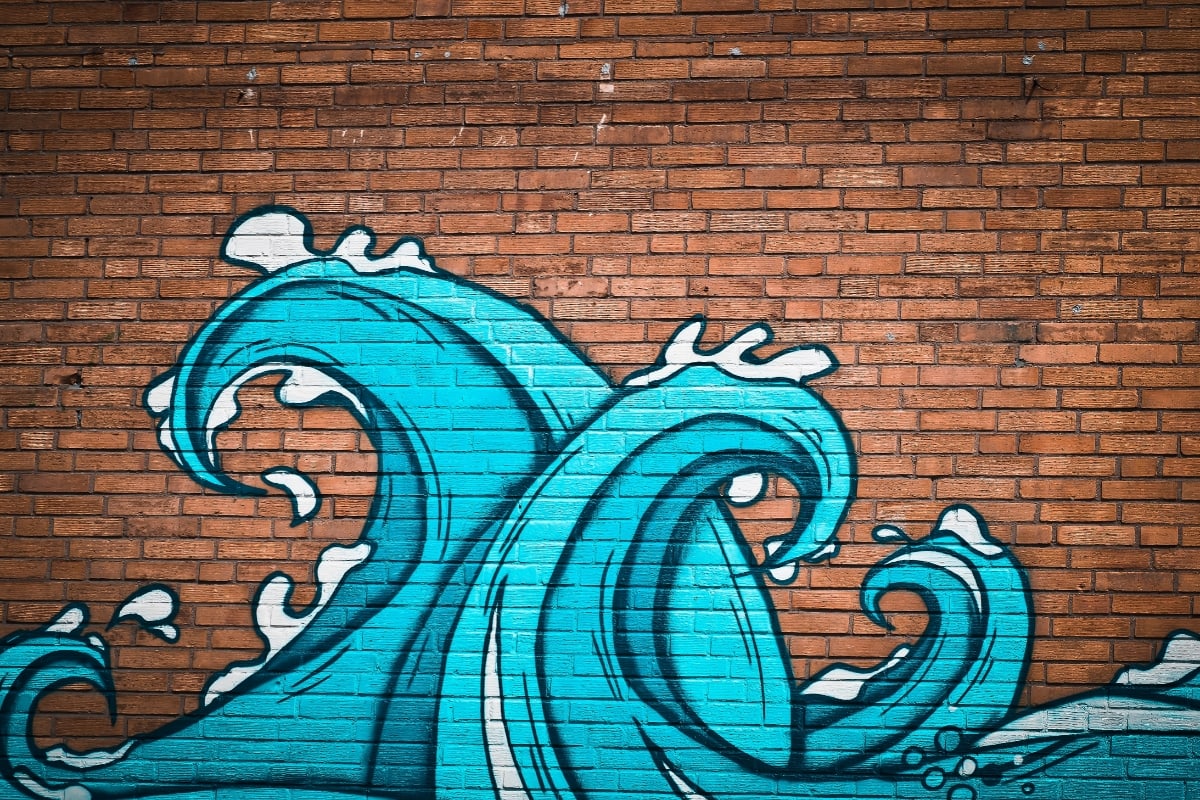
Graffiti is a contemporary urban art technique where various mediums are used to create public, often colorful and expressive, artworks on walls or surfaces. Today’s most famous graffiti artist is the infamous Banksy, whose works fetch millions of dollars when they come onto the market. Even now, Banksy’s true identity is unknown.
Grisaille
The grisaille technique uses only shades of gray to create volume and depth and is usually used by artists for underpainting or decorative purposes.
Impasto
The impasto technique involves applying thick layers of paint onto a canvas to create texture and give the artwork a three-dimensional look.
Miniature Painting
Miniature painting is a precise, highly detailed technique that’s used to create tiny artworks and is often seen in historical illuminated manuscripts.
Mural
Murals are very large paintings that you see on walls or ceilings inside or outside houses, usually to tell a specific story or for decoration.
Oil Painting
Oil painting uses oil-based paints where the colors and pigments are mixed with some kind of oil, typically linseed. This painting technique allows the artist to blend and layer the paints to create various effects on canvas.
Panel Painting
Panel painting basically involves painting on a wooden panel for decorative purposes to brighten up your home.
Panorama
In panorama painting, you create a wide-angle landscape or scene, typically in a long, horizontal format.
Perspective
The perspective painting technique creates the illusion of three-dimensionality and depth in two-dimensional artworks by making objects look like they’re realistically positioned in space.
Plein-Air Painting
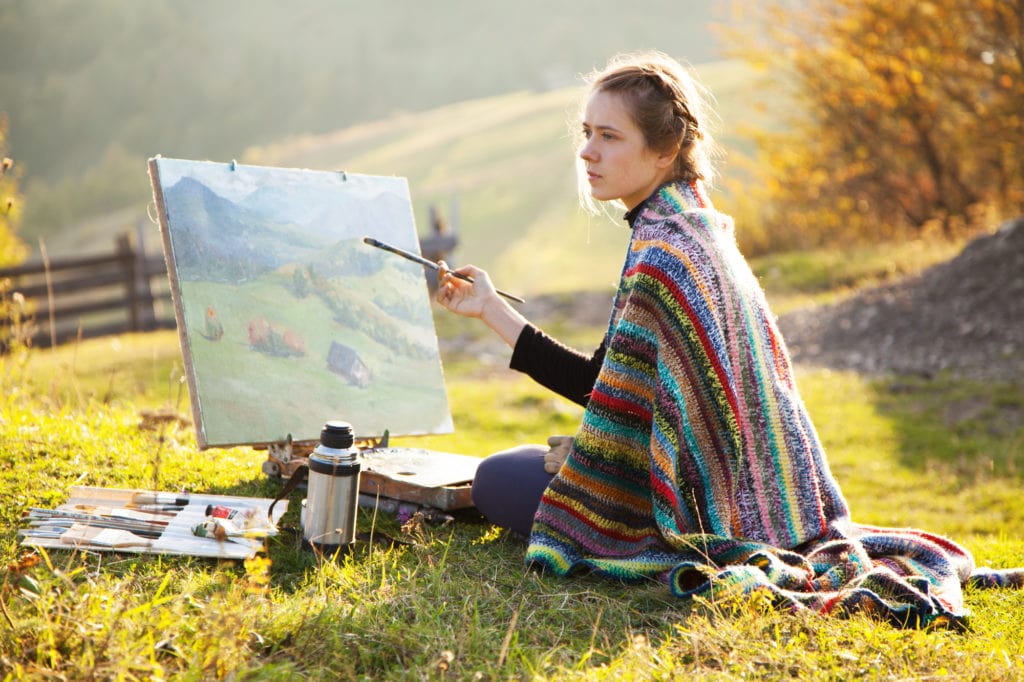
This painting technique involves working on your artwork out of doors, taking inspiration from the environment, and capturing natural light.
Sand Painting
Sand painting is a Native American art form that uses colored sand to create detailed, intricate patterns and designs.
Scroll Painting
Scroll painting is a traditional Asian painting technique where artworks are created on long Scrolls of paper or silk and are typically used for storytelling.
Sfumato
Leonardo da Vinci famously favored using the sfumato painting technique, using subtle transitions between colors and tones to create a soft, smoky effect in some of his work.
Sgraffito
This painting technique involves scratching through a layer of plain pigment to reveal layers of different colors beneath, allowing you to create pretty, delicate designs.
We used this technique during art lessons in junior school. First, we used colored wax crayons to scribble random bands of color on a piece of paper. Then, we painted over that with matte black poster paint. Once the black paint had dried, we used a compass point to create designs by scratching the paint away. As I recall, skeletal winter trees and individual leaves were popular choices for an image to create!
Sotto In Su
The phrase “sotto in su” means “from below upwards” in Italian and is a painting technique where the illusion of looking up at a scene from below is created, challenging the viewer’s perception of the picture.
Tachism
This painting technique is a modern, abstract style where the artist uses very spontaneous brushwork to put across energy and emotion.
Tempera Painting
Tempera painting is a technique that uses colored pigments combined with a binder like egg yolk. This form of artwork is renowned for its luminous quality and fine detail.
Tenebrism
This is a very dramatic painting style that uses intense contrast between light and dark and is often associated with the artist Caravaggio’s works.
Tromp L’oeil
Tromp L’oeil is French for “deceive the eye.” This painting technique is used to create realistic, three-dimensional images and, as you might guess from its name, is typically used to create optical illusions in paintings.
What Are The Different Painting Styles?
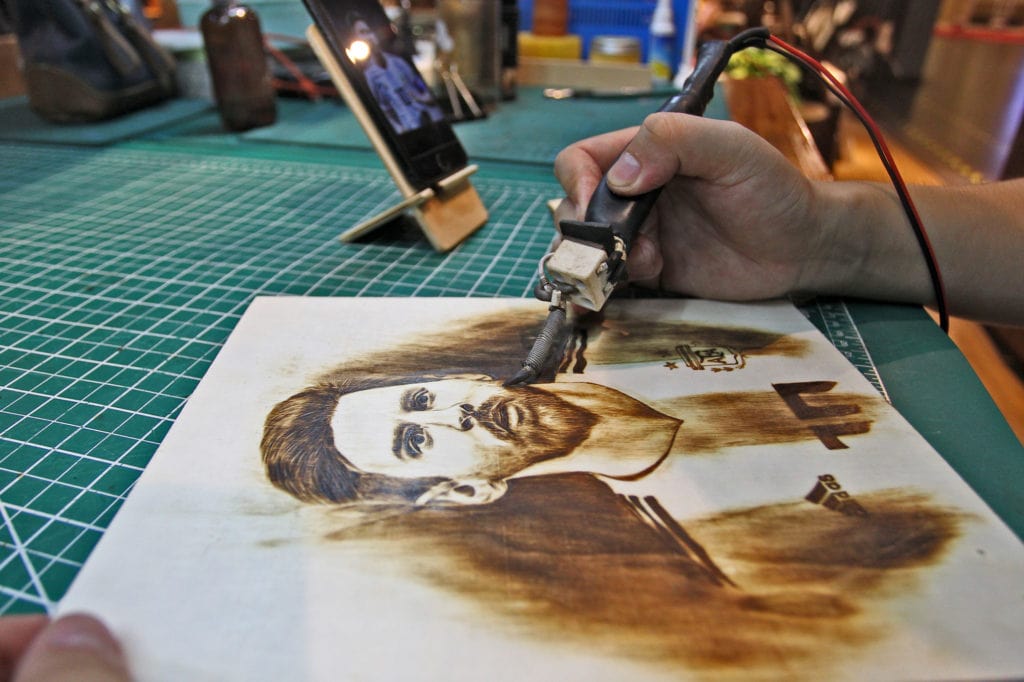
The different painting styles have evolved and changed throughout the ages and include traditional styles like Rococo, Renaissance, and Baroque, and more modern ones, such as Pop Art, Cubism, and Surrealism.
There are so many art styles to consider, you’ll never be short of inspiration.
Realism
The Realism painting style appeared in the mid-19th century and represented the world as it is. These artists wanted to portray everyday life, the working classes, still-life subjects, and social issues of the time realistically. To do that, realist painters used naturalistic lighting, colors, and very precise brushstrokes to produce a true-to-life image without embellishment or stylization.
Realist painters used various techniques, including glazing, impasto, and alla prima, to achieve the desired effect.
Impressionism
Impressionism originated in France during the late 19th century. This style of painting captures a moment in a scene rather than precisely and accurately depicting the details.
Loose brush strokes, vibrant colors, and natural light are typically used to create an impressionist painting, so artists often work outdoors to enable them to capture the changing light and atmosphere of a scene. Optical color mixing, or pointillism, which involves placing small dots of pure color next to one another to create the illusion of a blended shade when viewed from a distance, is also a popular impressionist technique.
Impressionist artists usually begin with a rough sketch and then build up the painting in layers, starting with lighter color tones and gradually adding darker ones. The final painting is a vibrant, atmospheric image that captures the essence of the scene rather than its precise details.
Post-Impressionism
Post-impressionism appeared as a reaction against the limitations of the Impressionism style of painting. These paintings use thick brush strokes and vivid colors and include abstract or symbolic elements that explore their subjects’ psychological and emotional aspects rather than just their appearance.
Famous Post-Impressionist painters include Vincent van Gogh, Paul Cézanne, and Georges Seurat.
Expressionism
Expressionism is a style of art where the image of reality is distorted to express the artist’s ideas or emotions. In this art style, colors can be extremely intense and unnatural, brushwork is free, and paint application tends to be highly textured and generous.
This art style is often mystical and emotional and is viewed by many as an extension of Romanticism. “The Scream” by Edvard Munch is an example of Expressionism.
Cubism
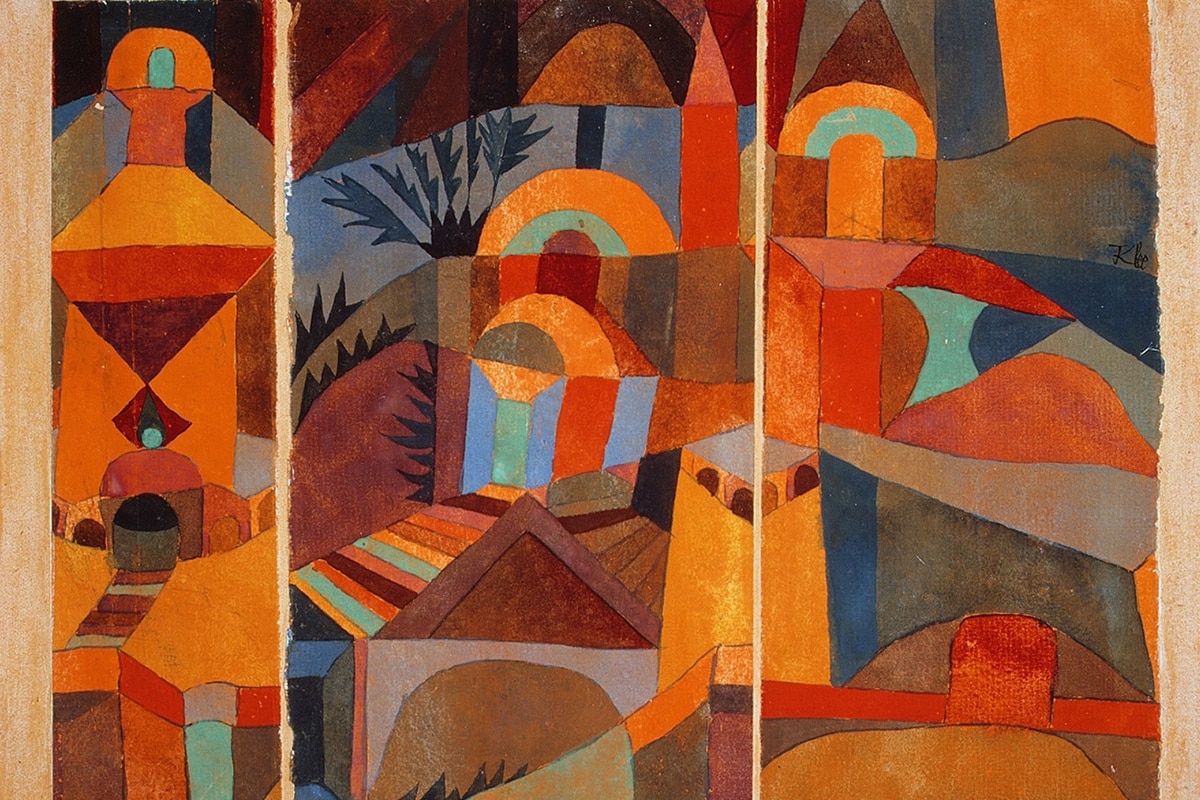
Cubism originated in the early 20th century, uses geometric shapes, and breaks down objects into small, fragmented pieces. This art style was developed by Pablo Picasso and Georges Braque and is considered one of the most influential art styles of the period.
To create a Cubist painting, you would typically break down your chosen subject into squares, rectangles, and triangles, and then reassemble them in a way that conveys the essence of the subject rather than depicting it realistically. Artists often use limited color palettes and a technique called collage, where they incorporate real-life objects like newspaper clippings or pieces of fabric, into their paintings.
Surrealism
Salvador Dali, Rene Magritte, and Max Ernst are all famous Surrealists you might have heard of. This art movement began in the 1920s and uses dreamlike, fantastical images that are often unsettling or bizarre.
To produce this kind of artwork, you would use techniques like juxtaposition, unexpected scale, and distortion to create an image that is dreamlike and illogical. Bright, bold colors and different materials and textures can be used to create a sense of otherworldliness.
Abstract Expressionism
Abstract Expressionism emerged in the 1940s in America and uses large canvases and spontaneous brushwork to convey a sense of energy and movement and express the artist’s feelings and emotions.
You can use canvas or paper, oils or watercolors to create this art form, but remember to be spontaneous and let your feelings guide your creative process.
Pop Art
Pop Art is an art style that emerged in the 1950s and is easily recognized by its use of vibrant colors, bold patterns, and images taken from popular culture.
To create a Pop Art piece, choose a subject that’s associated with popular culture, such as a celebrity, a product logo, or a comic book character. You can use a variety of mediums to create your Pop Art project, including painting, drawing, or digital art. Use bright, bold colors and patterns to create a sense of vibrancy and excitement, and try a technique called halftone, where you break down an image into a series of dots or lines to create a graphic, comic book-like effect.
Minimalism
Minimalism is a 1960s art style that uses simple forms, geometric shapes, and monochromatic color palettes. Many artists specializing in this art style use materials like steel, concrete, and glass to create sculptures and installations. Minimalist painters use large, flat areas of color and simple geometric shapes to create a sense of order and simplicity.
Fauvism
The Fauvism art movement originated in early 20th-century France and is widely regarded as one of the first avant-garde modern art movements. This form of art uses bright, bold colors and simplified images to convey intense emotions.
Artists, including Henri Matisse and André Derain, practiced Fauvism, using nature and landscapes as their subjects and experimenting with color, often in surreal ways.
Renaissance
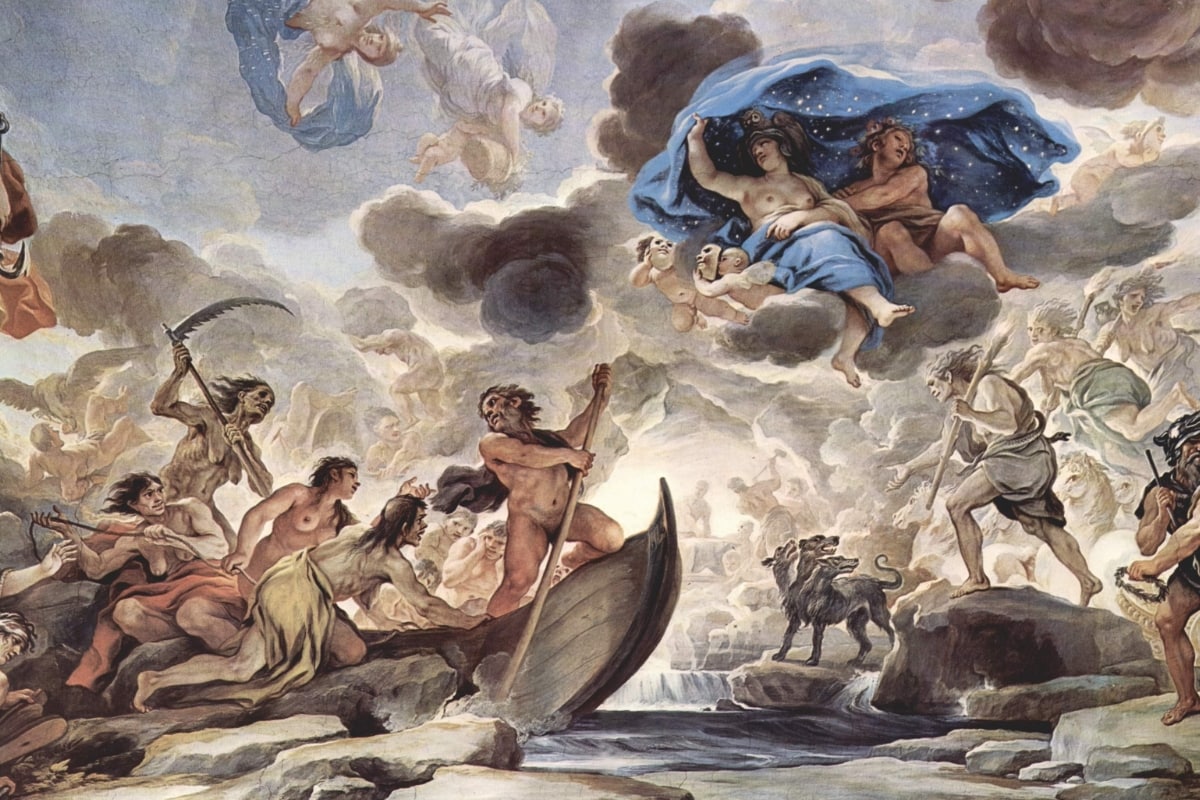
Renaissance art came out of Italy in the 14th century and spread throughout Europe over the next couple of centuries.
This form of art uses perspective, chiaroscuro (the use of light and shadow to create depth), and sfumato (softening the edges of objects to create a hazy effect) and focuses on realism and human emotion.
Artists such as Leonardo da Vinci, Michelangelo, and Raphael created some of the most iconic Renaissance works of art in history, including the Mona Lisa, the Sistine Chapel ceiling, and The School of Athens. So, if you opt to take up this painting style, you’re in very good company!
Baroque
The Baroque art style came from Rome, Italy, early in the 17th century and rapidly spread throughout Europe over the next hundred years.
This art style is highly ornate, extravagant, and dramatic and was often used to depict religious scenes, especially for the Catholic Church. Baroque uses intricate details, extravagant motion, and intense human emotion to create dynamic and somewhat over-the-top artworks.
Some of the most famous Baroque artists include Caravaggio, Bernini, and Rubens.
What Is The Difference Between Painting Techniques And Painting Styles?
The difference between painting techniques and different painting styles is shown below:
Painting Techniques
- Techniques are technical skills
- A technique is a method or procedure used to apply paint to canvas, paper, or another medium
Painting Styles
- A painting style is the way in which an artist represents an idea
- The different painting styles use various techniques to get the look the artist wants
What Are The Benefits Of Knowing The Different Kinds Of Painting Techniques And Styles?
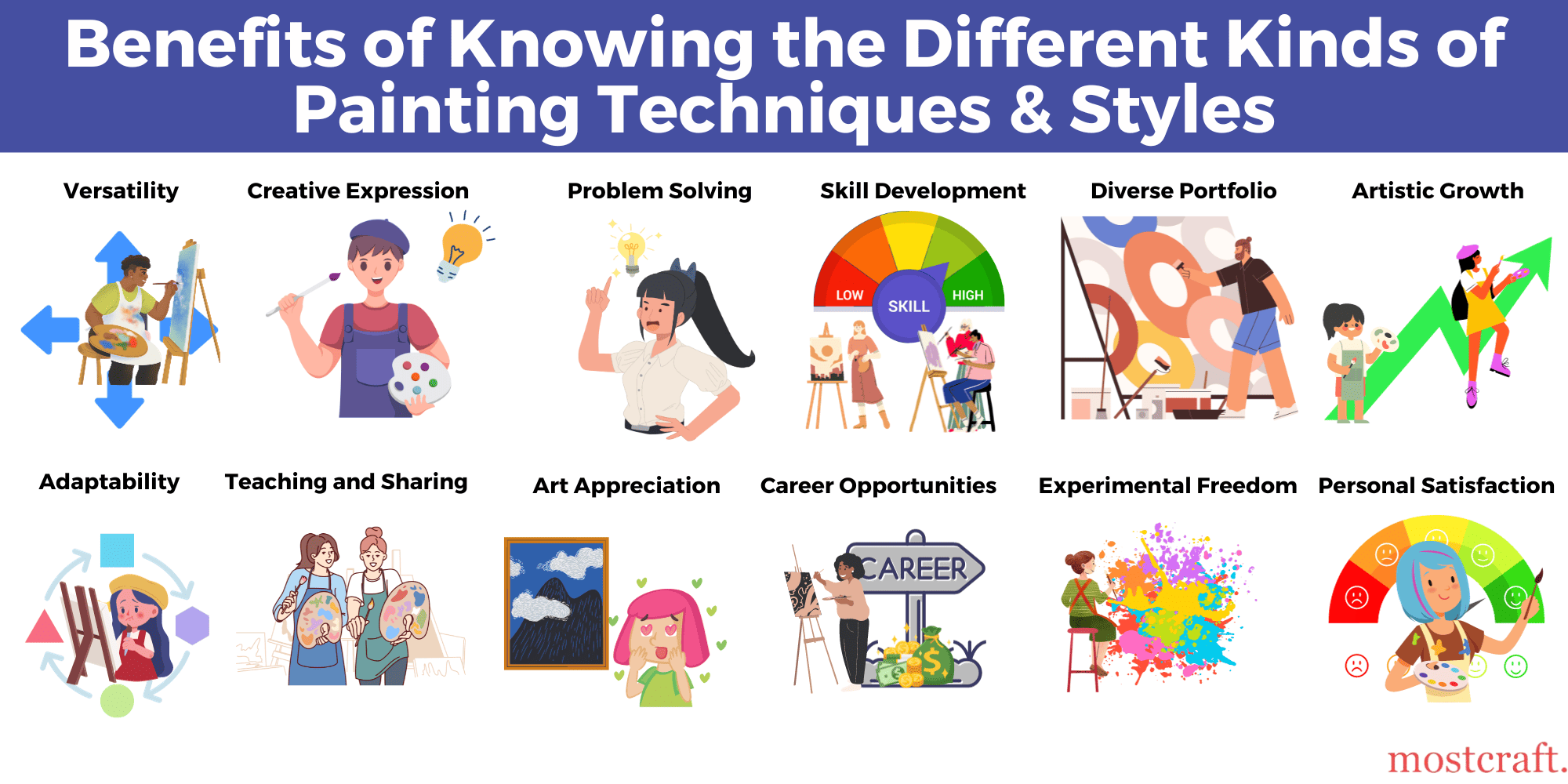
The benefits of knowing the different kinds of painting techniques and styles are explained in this section of our guide.
Versatility
If you have a clear understanding of all the various painting techniques and styles, you will be a much more versatile artist.
Creative Expression
Many of the painting styles we’ve described in this article demand a lot of creative expression and essentially putting your feelings and emotions on paper. If that sounds like something you could do, choose an art form that demands plenty of emotional input.
Problem-Solving
Getting your head around a particular painting style or technique is not always straightforward and easy, so you will need to develop good problem-solving skills to accomplish your end goal.
Skill Development
As well as mastering different techniques, your skills as an artist will develop as you go along. Skill development is not only important for this hobby, but it can be extremely beneficial in your work life too.
Diverse Portfolio
Learning and understanding different paint techniques and styles will enable you to develop a very diverse portfolio, which is essential if you hope to make a career out of art.
Artistic Growth
You won’t be able to grow artistically if you restrict yourself to one particular style and a limited range of techniques. By exploring different styles and practicing various techniques, your artistic growth is assured!
Adaptability
As you try learning different painting techniques, you’ll start to understand how to use paint and other mediums, making you highly adaptable.
Teaching And Sharing

As you become proficient in your chosen art style, you could begin to share your knowledge and skills by teaching other newcomers your particular specialism. That’s not only good fun, but it could help generate an extra income if you start teaching art professionally.
Art Appreciation
Understanding the complexities and technical challenges of different art styles and techniques will give you a greater appreciation of art in general.
Career Opportunities
As previously mentioned, if you become skilled in your chosen art style and techniques, you could make a career out of teaching others.
Experimental Freedom
Some art styles encourage experimental approaches and allow you unlimited freedom to express yourself through the mediums of paint and canvas or paper.
Personal Satisfaction
Learning any new skill can provide you with a great deal of personal satisfaction and feelings of accomplishment, and that’s definitely the case when it comes to learning different painting techniques and styles.
How Do I Start Learning The Different Painting Techniques And Styles?
To learn the different painting techniques and styles takes time and effort, but all your hard work will be worth it in the end when you have a beautiful painting to display in your home.
Here are some tips on how to start your journey.
Gather Your Materials
The materials you need will depend on what kinds of techniques you want to use. Here’s a list of some basics you’ll need for your toolbox.
- Paints
- Paper or canvas
- Pencils
- Easel
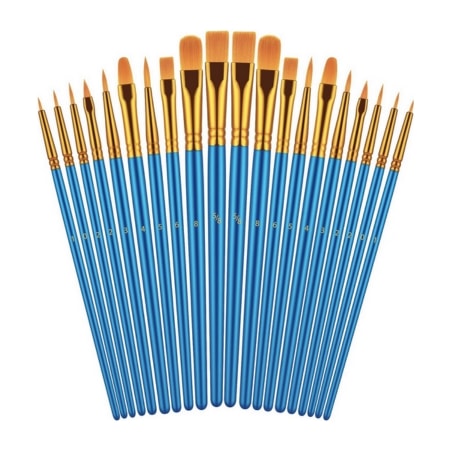
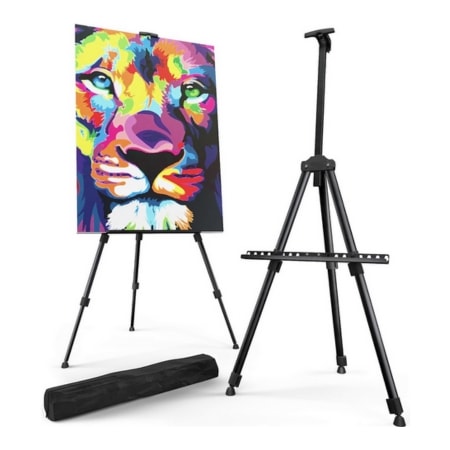
Choose Your Medium
You can paint in oils, acrylic, or watercolors, so before you start, you’ll need to choose what medium you want to work with.
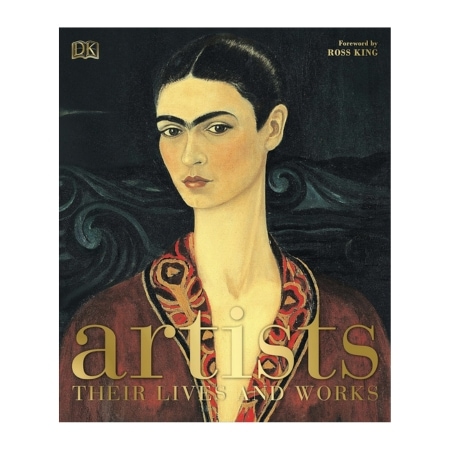
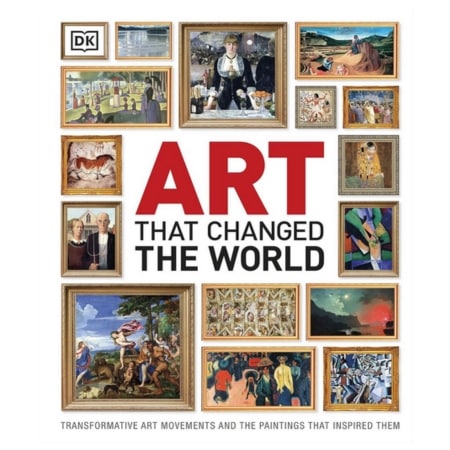
Study Art History
Studying art history gives you a great deal of knowledge and inspiration for future projects, so we recommend getting hold of a few books on the subject and spending time reading them before you begin.
Take Online Courses Or Workshops
If you’re a beginner, we strongly recommend taking online courses or workshops, where you can learn the basic techniques you’ll need for your chosen art style.
Here are a few providers to consider:
- Skillshare – offers a variety of classes on painting, drawing, illustration, and more.
- Udemy – has a wide range of courses on different art styles, techniques, and software tools like Photoshop and Illustrator
- Coursera – provides online art courses from top universities and institutions around the world
- The Virtual Instructor – offers courses on drawing, painting, and mixed media.
Read Books And Manuals
To back up your online study, it’s a good idea to read books and manuals on the painting techniques you want to learn, as they provide in-depth insights that can complement your digital resources.
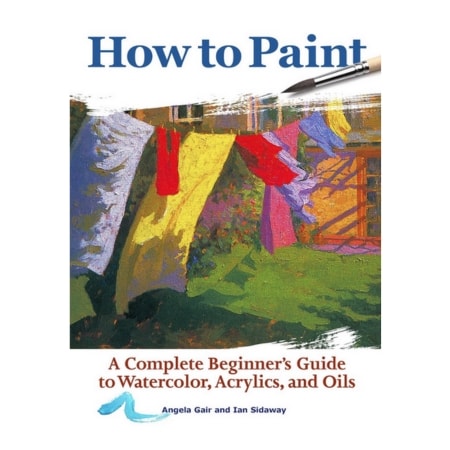
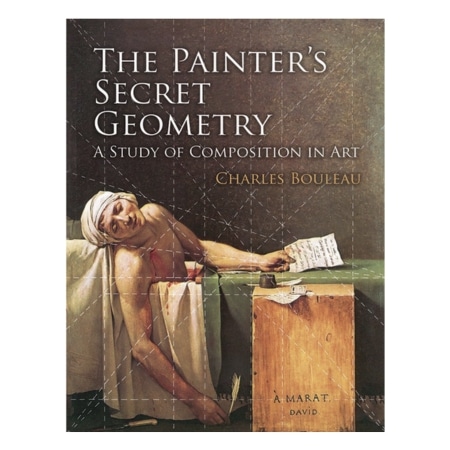
Practice Regularly
The best way to improve is by practicing your art regularly. It might be that you struggle at first to get your head around a new technique, but practice makes perfect, so don’t give up!
Copy Masterpieces
Masterpieces, such as the Mona Lisa and The Scream, can be a fabulous source of inspiration for budding artists. Try to copy some of these amazing works to learn how the artist used his chosen technique and improve your own skills.
Experiment And Explore
As you have learned already, there are many different techniques and styles to try. Throughout your artistic journey, don’t be afraid to experiment and explore to find out what suits you best.
Seek Feedback
Don’t be afraid to ask your family and friends for feedback on your artistic efforts. Those close to you will undoubtedly be honest and tell you exactly what they think of your work!
Join Art Classes Or Workshops
When you take up any new craft, the best way to learn is from other, more experienced crafters, and learning to paint is no different. Find some classes or workshops in your area and join. That way, you’ll make new friends and learn too.
Attend Art Exhibitions And Museums
Art exhibitions and museums can be a fabulous source of inspiration for budding artists, so take time out to go and visit some. Some exhibitions also feature demonstrations and interviews with their artists; you don’t want to miss out on them!
Document Your Progress
It’s a good idea to make a note of your progress. That ensures you won’t forget any handy hints you’ve picked up or lose sight of how you’ve developed.
Be Patient And Persistent
Patience is essential when learning any new skill, including how to paint. You can’t expect to be as good as your artistic idols overnight, so be persistent and stick to it to make progress and achieve your goals!
FAQs
In this part of our guide, we answer some of the most frequently asked questions about types of painting techniques and styles.
What Are The Essential Tools For Mastering Painting Techniques And Styles?
The essential tools you’ll need to master different painting techniques and styles include the following:
- Paper or canvas
- Paints, depending on what style of art you want to pursue (oil, acrylic, watercolor)
- Selection of paint brushes
- Pencils
- Pencil sharpener
- Pencil eraser
- Work light
- Straight edge ruler
- Notebook
- Easel
- Paper cutting tool
- Artists’ tape
You’ll also need to acquire a few reference books on the painting technique and style you want to master.
How Can I Achieve Vibrant Colors In My Arts And Crafts Projects Using Various Painting Styles?
There are several ways in which you can achieve vibrant colors in your arts and crafts projects.
- Use a white base layer before applying your colors. That will make the colors appear brighter and more vibrant.
- Mix the colors with a medium that’s designed to enhance their vibrancy, such as a gloss or matte medium.
- Experiment with layering the colors to create more depth and complexity.
If you can’t get the brilliant colors you want, it might be worth trying a different painting style and technique that works better for you and your artistic vision.
Are There Beginner-Friendly Painting Techniques And Styles For Aspiring Artists?
Yes, there are plenty of beginner-friendly painting techniques and styles available for aspiring artists to try.
The most popular techniques for beginners include acrylic painting, watercolor painting, and oil painting. Some good beginner-friendly painting styles include realism, impressionism, and post-impressionism.
These techniques and styles are great for beginners because they are easy to learn, need minimal supplies, and offer plenty of scope for experimentation and creativity.
How Can I Transition From Traditional To Digital Painting Methods?
The transition from traditional to digital painting methods can be somewhat daunting, but it’s definitely doable with patience and practice.
- Start by investing in a graphics tablet and stylus. That will give the same feel as traditional painting methods, allowing you to use your hands to create Strokes on a digital canvas.
- Choose the right software that best suits your needs. Adobe Photoshop, Procreate, and Corel Painter are all good choices.
- Start by learning the basic techniques, such as simple brush strokes, layering, and blending, to get a feel for the software.
- Be prepared to practice and experiment with different brushes, textures, and effects to create your own unique style.
Making the transition to digital painting methods might take some time, but with practice and patience, you’ll be creating stunning digital art in no time at all!
What Are The Benefits Of Acrylic Pouring In Arts And Crafts?
Acrylic pouring is a popular technique in arts and crafts, and it has several benefits.
- Acrylic pouring allows for lots of experimentation and creativity since your colors and patterns are unpredictable and totally unique.
- The acrylic pouring technique is easy to learn and doesn’t need any artistic skill to produce beautiful results.
- Acrylic pouring produces a textural, highly tactile finish to your artwork, which adds depth and interest to your projects.
- Acrylic paint is water-based and non-toxic, making it safe to use and easy to clean up.
Where Can I Find Online Resources Or Courses For Mastering Painting Techniques And Styles?
There are plenty of online resources and courses on offer for mastering painting techniques and styles.
A few popular options include websites like Skillshare, Udemy, and Coursera. Here, you can find a wide range of courses taught by experienced artists. Art galleries often offer online courses and lectures on different painting techniques and styles and don’t forget to check out YouTube channels run by professional artists who will share their knowledge and tips for free.
Which Painting Techniques Work Well For Creating Intricate Details In Arts And Crafts Projects?
Some painting techniques work extremely well for creating intricate details in your arts and crafts projects, including stippling, cross hatching, dry brushing, and sgraffito.
- Stippling involves using a brush to create tiny dots or points to give texture and shading.
- Cross-hatching uses intersecting Lines to give depth and texture to your art.
- Dry brushing uses a dry brush to create a textured, subtle effect.
- Sgraffito involves scratching a layer of paint to reveal the colors underneath, enabling you to create intricate designs and patterns.
How Can I Incorporate Painting Techniques And Styles Into DIY Home Decor Projects?
There are lots of ways in which you can incorporate painting techniques and styles into a DIY home decor project.
- You could create a statement piece of artwork by using a large canvas or creating a mural on a wall.
- Smaller decor items like picture frames, vases, and furniture pieces can be decorated using various painting techniques.
- Try experimenting with different techniques like stenciling, layering, or using metallic paint to give your projects a unique look.
- Paint a series of smaller canvases or create a gallery wall featuring a mix of art styles and techniques.
The possibilities for incorporating art into DIY are endless, so have fun and let your creativity take over!
Conclusion
Taking up painting as a hobby can be an extremely relaxing and satisfying way to spend your free time. Whether you have ambitions to start teaching others or you simply want to produce some attractive artwork to display in your home, you’ll need a basic knowledge of the different painting techniques and styles.
Take time to read books on art history, check out your local art galleries, exhibitions, and museums, and join a local artists’ community to learn more. Once you’ve decided what style of painting would suit you best, gather the materials you need, and set up a suitable workspace where you can paint and store your materials.
With practice and persistence, you’ll soon be well on your way to painting artworks your family and friends will be amazed by!